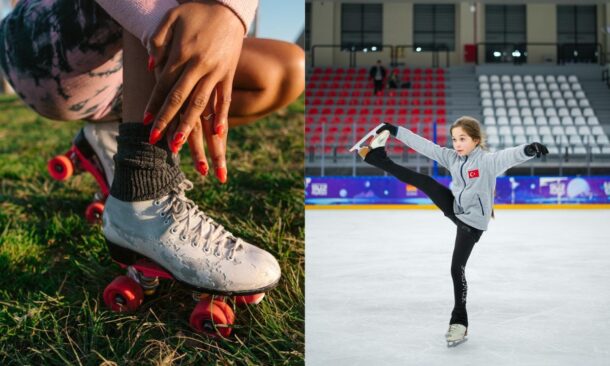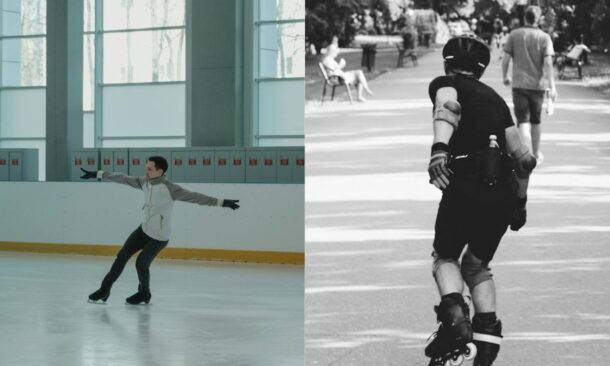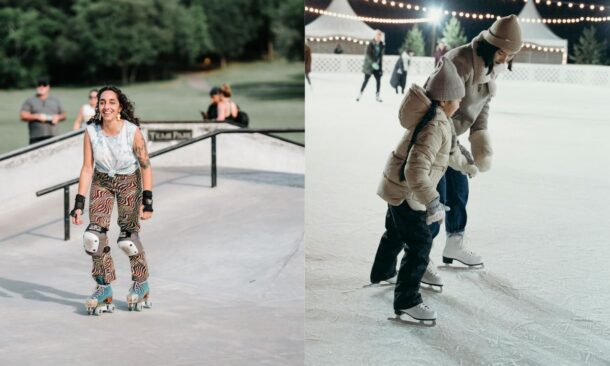Ice skating and roller skating are activities that share the fun and excitement with millions of people across the globe. They both require things like balance, coordination, and skill, yet there are also clear-cut differences that make one appear quite a lot harder than the other. So, is ice skating harder than roller skating? It is even an argument among skaters, beginners, and enthusiasts. In this article, we will go in-depth regarding the differences, challenges, and skills needed for both activities so that you can answer which one is harder.
The Basics of Ice Skating and Roller Skating
Before looking into the difficulty level, it’s important to understand the basics of both sports.
Ice Skating:
Ice skating is sliding on a frozen surface on metal blades under the feet that are attached to the bottom of specially designed boots. It occurs on ice rinks, frozen lakes, and rivers and encompasses all the disciplines within figure skating, ice hockey, and speed skating.
Roller Skating:
Roller skating is the act of traveling on land using wheeled skates. There are various types of skates, such as inline skates, with wheels set one in a straight line, and quad skates, having four wheels two in each line. Common activities include artistic skating, roller hockey, and roller derby.
The mechanics of both sports are the same, though each differs in terms of surface, equipment, and technique that may make one harder than the other, given experience and skill.
Also Read: How Many Hockey Players Are On A Team?
Surface and Friction: Ice vs. Ground

One of the biggest determinants in the ease or hardness of both activities is the surface they are done on.
Ice Skating – Slippery Surface:
Ice skating requires one to move on a slippery, smooth surface. On the ice, there is very little friction, so it is much more difficult for beginners to balance and control their movement. A misplaced step could send the skater slipping away or falling down. Ice is also less forgiving when you fall because it is cold and hard; a tumble could be quite painful.
Roller Skating – Solid Ground:
Roller skating occurs on solid floors, be it pavement, concrete, or wood. In roller skating, these floors provide a lot more friction and thus the skater can easily gain control over the skates and apply the brakes where needed. Rough or uneven surfaces may have hazards such as tripping over cracks or small sticks.
Result: Ice skating is harder to learn initially as less friction means more balance.
Differences in Equipment: Wheels vs. Blades
The equipment used in each sport also determines how challenging it is.
Ice Skating Blades:
Ice skates have a thin metal blade which makes the surface area touching the ground much smaller than that of a roller skate wheel. With this narrower base, more balance and control are required to stay upright and move efficiently. This also takes some time to learn: using the edges for turns, stops, and spinning.
Roller Skating Wheels:
Roller skates, whether inline or quad, have a larger surface area coming into contact with the floor. This gives better stability, and balancing is much easier for beginners. Wheels also create rolling resistance, making stopping and controlling speed a little bit more challenging.
Verdict: Ice skating is more challenging because the blades have a smaller base of support.
Also Read: Hockey Skates vs Figure Skates: What’s The Difference
Learning Curve: Which is Easier to Pick Up?

Generally speaking, for most people, the initial learning curve for ice skating is steeper than for roller skating.
Ice Skating:
It is harder for beginners to master basic balance on ice skates. The slippery surface and the narrow blade take some getting used to just to stand up, glide, and stop. Learning how to stop, turn, and skate backward can take weeks or months to learn.
Roller Skating:
Many people find it easier to pick up roller skating because of the stability of the wheels and also because of the grip created by the ground. Most beginners can grasp basic movement, balance, and stopping within the first few sessions. Advanced skills like jumps and spins still remain difficult to learn.
Verdict: The learning curve for roller skating is much more gradual, and it’s generally easier for a beginner to pick up.
Physical Demands and Muscle Engagement
Both sports require physical exertion and coordination but engage the body differently.
Ice Skating:
Ice skating requires more core strength and fine motor control to stay balanced on the slippery surface. The legs and glutes are heavily engaged in the actions of propulsion and control. More advanced movements, such as spins and jumps, require explosive power and exact timing.
Roller Skating:
Rollers skating also works out the legs, glutes, and core but is a bit more involved with stabilizing muscles due to the roll created by the wheels. Quad skates in particular require lateral balance and strength not to tip over.
Verdict: Both sports are physically demanding but ice skating could be more so, requiring fine-tuned muscle control due to the slippery surface.
Also Read: Meet the Most Entertaining Pokémon YouTubers This Year [Top 15]
Stopping and Control: Ice vs. Roller Skating

Stopping is one of the most important skills in both ice skating and roller skating. However, the techniques are quite different.
Stopping in Ice Skating:
Ice skaters usually do either a “snowplow” stop or a “hockey” stop, both of which involve digging the edge of the blade into the ice to create friction. These can be difficult for beginners and may take some time to learn.
Stopping in Roller Skating:
Roller skates usually have a brake, generally on the toe for quad skates or heel for inline skates. Brakes make stopping much easier for beginners, while advanced skaters normally use T-stops or power slides to stop, which require more control.
Verdict: Ice skating is harder in terms of stopping because of the precision needed to use the blade edges right.
Fear Factor: Falling and Injuries
Falling is an inevitable part of learning both sports, but the fear and consequences of falls can differ.
Ice Skating:
The ice can be more intimidating and hurtful to fall on due to its hard and cold surface. Beginners can be more fearful of this and will therefore be slower in the learning process.
Roller Skating:
Falling while roller skating can also be painful, especially on concrete or pavement, but the fear factor is generally lower because the ground is more predictable than ice. The risk of injury can be significantly reduced with proper protective gear—helmets, knee pads, and wrist guards.
Verdict: The fall of a person who was ice skating will be felt in a scarier way, so this aspect may be even more difficult to overcome in overcoming fear.
Also Read: What Does MVR Mean In Baseball?
Advanced Techniques: Which is More Difficult?

Now, talking about advanced moves, it becomes discipline-specific.
Ice Skating:
In figure skating, jumps, spins, and complicated footwork have to be performed with absolute control over the body while on the ice. In speed skating and hockey, advanced techniques such as crossovers and quick stops have to be perfected.
Roller Skating:
Advanced roller skating disciplines, such as artistic skating or roller derby, come with their complex movements as well—including spins, jumps, and quick maneuvering. Inline skaters can do tricks, grinds, and flips.
Verdict: Both are quite difficult at higher levels, although ice skating may involve a little bit more precision as the blades on the skates are thinner and there is less friction with ice.
Conclusion: Which Is Harder?
So, which is harder, ice skating or roller skating? Well, it depends on your view and experience.
For Beginners: The ice is harder because of the slippery surface, thin blades, and a lot more need for balance and precision.
For Advanced Skaters: It is hard to pinpoint which one is more challenging since each sport presents its unique challenges—ice skating calls for precision and control, while roller skating requires conquering rolling resistance and stability.
Ultimately, the “harder” sport is subjective and depends on things like your natural balance, athleticism, and comfort with the respective surfaces. Whether you go with ice skating or roller skating, both are great ways to be active, develop new skills, and have a good time. Why not try both and decide for yourself?
